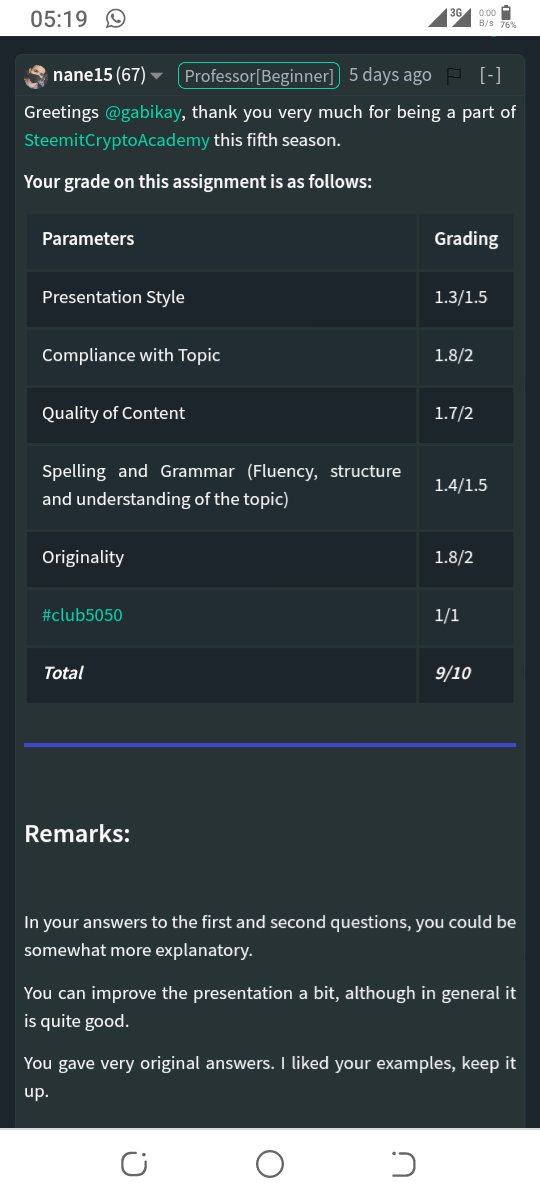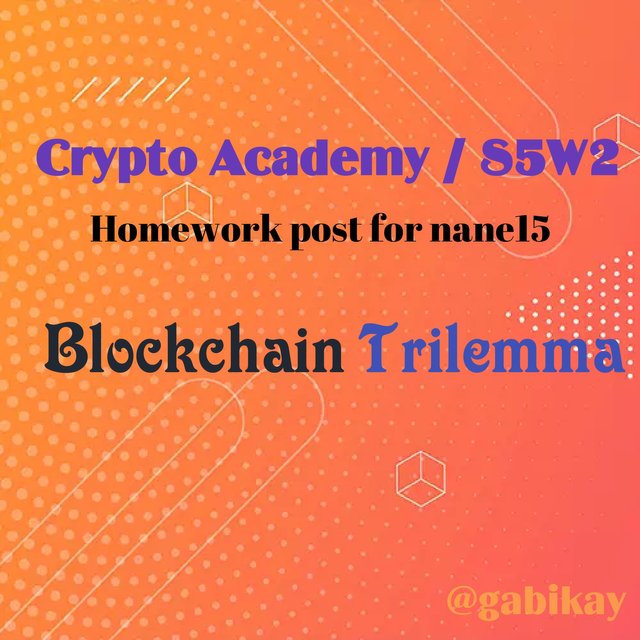

- Explain in your own words what the Blockchain Trilemma is.
Blockchain trilemma is a term that is used to describe the three ever challenging issue of Blockchain technology. It is a theory that explains that no blockchain can have decentralisation, scalability, and security simultaneously. This means that a Blockchain can only have one or two of these three features but must be lacking in atleast one of them. This lack in one of these features is not really on purpose to reduce the Blockchains efficiency but it is only a requirement to see that the Blockchain balances and functions as a Crytptographic product. For instance, you can't have thousands of nodes or validators and expect the network to be scalabe but with this, the security of the Blockchain is assured.

- Is the Blockchain Trilemma Really a Trilemma?
Blockchain trilemma highlights the challenge facing the Blockchain technology today as it relates Decentralization, Scalability and security. As I had stated earlier, it is not normally obtainable for a Blockchain technology to posse these 3 core features. Rather,it could posses only 2 at most and an attempt to posses the 3 will leave the Blockchain vulnerable to attacks. For instance, a highly decentralised Blockchain has to pay scalability as its price. Also, a highly scalabe Blockchain will have to sacrifice it's securit. Hence, each blockchain has to pick two features which it intends to keep constant at the expense of the third one and that is what trilemma is all about.

- Define the following concepts in your own words:
A. Decentralization
B. Scalability
C. Blockchain Security
Decentralization:
This is the main stay of every Blockchain network that is established today. Blockchain technology goal is to create a financial system that doesn't need intermediaries and is not influenced by any authority (government) or single entity at all. It has been proven that the intervention of intermediaries has caused a lot of slag in the central financial system. These slags include;
• Insecurity
• Centralisation
• Transaction difficulty
• government regulation and more.
These challenges were discovered long ago but a system to solve all this problem in one technology was sought for. Then came Cryptography. With Blockchain technology today, financial transactions are made safer, without prying eyes, and free from government stringent conditions.
However, the more decentralised a Blockchain network gets, the safer it becomes but consequently, the transaction speed is reduced (scalability).
Blockchain security
This is the second main stay of a Blockchain technology. In a Blockchain, the minting of new tokens is done by nodes or validators. These people are vested with the responsibility of ensuring that no one cheats the network by means of double spending or even hacking thereby keeping the network safe in all forms. When ever they verify transactions, it is added to the block and then by some certain criteria, they are rewarded with the networks token which they are securing.
Now, this security is not vested upon the hands of just a few people else the system will still be manipulated by a cordinated attack since the security circle is small. Hence, the miners/nodes/Validators or so many that for each block to be validated, it has to pass through all the validators the network has. This in turn brings maximum safety of the Blockchain technology but at the expense of the networks throughput (scalability).
Scalability
When we speak about Scalability with respect to blockchain technology, we simply define **the amount of transactions which the Blockchain is able to validate in a given time (1 second). It is not enough to say that you have sent some amount of token to a person until that your transaction is validated and added to the blockchain. Normally in a centralised financial system, the function of validation rests on the shoulders of one man or a centralised entity hence transactions are immediately confirmed. When it comes to Blockchain technology, there are thousands of people who act as Validators and every transaction detail must pass through them before getting verified. This in turn causes the slow down in the confirmation of transactions.
However, this is and has always been a challenge to the Blockchain technology which has caused a slow down in Blockchain adoption rate.

- Based on your knowledge, explain at least two viable solutions to the challenges posed in the Blockchain Trilemma.
To solve the Blockchain trilemma, there are two types of methods that could be employed and they are;
Layer-1 solutions
These solutions refer to adjustments or developments done in a blockchain network (mainchain) just to make it to scale better.
Layer-2 solutions
This kind of solution entails that a blockchain network (mainchain) will be aided by another blockchain project( side chain) in the processing of transaction information so as to scale better. For example, a Layer-2 solution like Lighting network is built to help increase the transaction speed and efficiency of Bitcoin protocol.
Below are some Layer-1 1 and Layer-2 solutions
Sharding Method (Layer-1)
If 10 people were given the responsibility to count a local broom one after another just for security reasons, it surely would take some time to get to the last man. What if this broom was then loosened and then shared amongst the 10 people for simultaneous counting, then it can be observed that their speed of producing an output will be greater.
Sharding is a layer-1 scaling solution whereby the supposed transactions to be validated in a block (usually PoW) is usually sharded or broken into smaller pieces known as shards. The shards processing then begins simultaneously by various nodes. This will bring about a faster output. Also, instead of each node holding data from genesis to present block, the Blockchain is split or sharded into different peices and various nodes will hold various shards. The mainchain recieves preofs from various Shards and these Shards employ Cross-shard communication protocol to be able to relate with each other so as to share general state, addresses and balances.The use of sharding solution is common in blockchains like Qtum, Zilliqa, Ethereum and Tezos.
1. Improvement on Consensus mechanism (Layer-1)
A blockchain network like Bitcoin makes use of Proof of Work consensus mechanism (PoW). Irrespective of the fact that PoW is secure, it is very slow because the transaction details has to pass through all the nodes in the network before being confirmed and then added to the block. Instead of PoW, it could adopt Proof of Stake (PoS) which doesn't require the minners to solve Crytptographic problems (time which could have been used to validate another block).
2. Sidechains (Layer-2)
When I was in my pimary education level, my tuition fee was paid in two ways. Either directly to the school director or at the stipulated school bank account. If it was paid to the school director, then he later will still go to the bank to pay in the cash which he holds. This made various options for parents with various choices.
The sidechain idea is something alike this. The sidechain is some kind of an alternative blockchain that can process transaction data and later feed it back to the main chain. It is structured in a way that it doesn't alter any information given to it. It has its own validators as well and uses a suitable Consensus mechanism that may differ from that of the main chain. It's goal is to process transactions of it's designated blockchain network thereby easing the stress and volume of work done by the main chain. In return, it increases the Scalability of the Blockchain it helps without infringing on the Blockchains security or decentralised nature. Example of a sidechain for Bitcoin network include Liquid Network and Rootstock.

Conclusion

The trilemma that exist in Blockchain industry is in reality a stumbling block in the wide spread adoption of Blockchain technology. These trilemma highlights that it is impossible for a Blockchain network to boast Decentralization, Scalability, and security simultaneously and it has been proven to be true.
Over five solutions are currently in use by some Blockchains to overcome this trilemma. Some of this solutions include PoS adoption, Sidechain adoption, state channel adoption, sharding and more.

Regards to professor @nane15
.png)
.png)